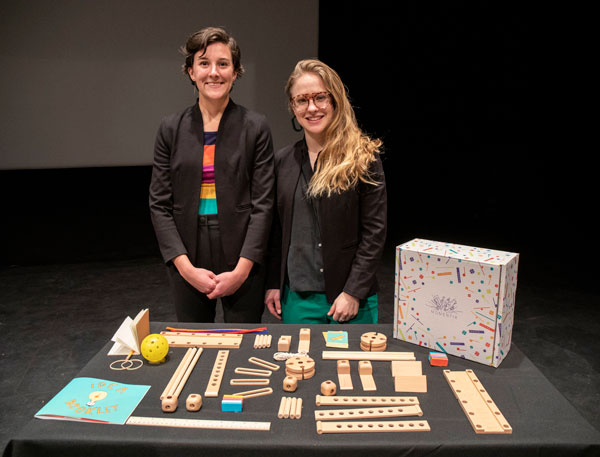Alana Aamodt ’18 and Anna Gilbertson ’19
Opening up Physics to a New Audience
A domino falls over, nudging a ball to roll down a series of ramps. Eventually, the ball triggers a lever that turns on a light.
Rube Goldberg machines, sometimes called chain-reaction machines, are fun to build. They go viral on the internet. They also happen to be perfect educational tools for teaching the basic properties of physics.
But, they can be intimidating to make.
That's where Momentix comes in.
"It's a really intimidating thing to make a Rube Goldberg machine from scratch, so we're hoping this is the starting point for making your own," says Momentix team member Alana Aamodt '18. Momentix's open-ended toy kit upcycles old toys to create chain reaction machines.
Aamodt and Anna Gilbertson '19 took first place honors and $15,000 in seed money at Colorado College's Big Idea competition in 2019. The seventh annual Big Idea competition was held Thursday, Feb. 7, in the Celeste Theatre in the Cornerstone Arts Center.
Aamodt, a physics major, and Gilbertson, a physics and integrative design major, took third place in 2018 with their kit designed to use creative fun to transcend inequalities in STEM (science, technology, engineering, math) programs. Momentix kits provide resources like a programming booklet and challenge cards to teach kids basic physics terms, in addition to the raw materials and connecting pieces to build a Rube Goldberg machine. The toy kit is aimed at kids ages 8 to 12.
"Momentix was just an idea last year," says Aamodt. "This year it was more than that."
Gilbertson says she and Aamodt started Momentix to increase diversity in STEM fields.

Momentix kit
"It makes physics more approachable to kids," she says. "The age group we are targeting is an age group where participation in STEM starts to drop among girls and people from underrepresented groups. So we hope that by emphasizing creativity in our kit, we can keep those kids involved."
Aamodt has had a lifelong love of Rube Goldberg machines. Her fascination with them form the roots of Momentix, particularly an experience she had in fifth grade.
"I had an assignment to make one and I remember that I was really jealous of my neighbor's, because his dad had helped him make his. It was made out of wood and worked perfectly. Mine was made out of duct tape and cardboard and it had a lot of good ideas behind it but it didn't work really well. Maybe I just held onto that for all these years," Aamodt says.
"Momentix came out of a desire to make physics more fun and make something that fifth grade me would have wanted to play with."













